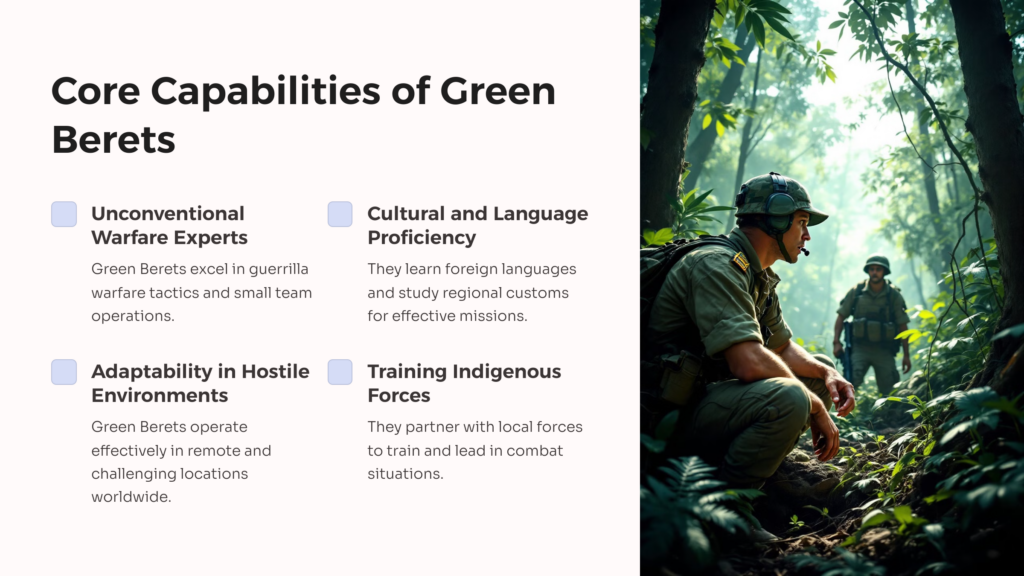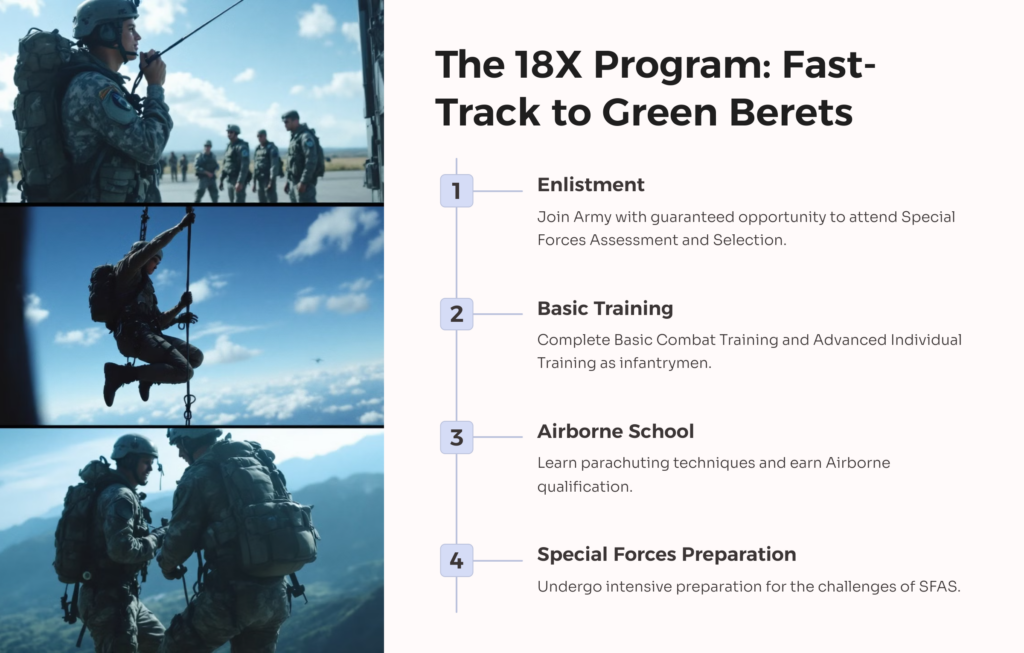
Green Berets are the elite Special Forces of the U.S. Army, recognized by their iconic green berets and renowned for their expertise in unconventional warfare, foreign internal defense, direct action, and special reconnaissance. Operating in small teams, they excel in guerrilla tactics and often work in remote, hostile environments, training and leading local forces. What sets them apart is their extensive training, which includes mastering at least one foreign language and gaining deep cultural knowledge, skills that enable them to build trust and execute sensitive missions with precision.
Requirements to Join the Green Berets
Becoming a Green Beret is no easy task. The U.S. Army has strict requirements for any Special Forces candidate who wishes to join this elite group.
- Candidates must be U.S. citizens between the ages of 20 and 30
- Must also have a high school diploma or equivalent, although a college degree is preferred
- Must be able to pass a rigorous physical fitness test, which includes push-ups, sit-ups, pull-ups, a two-mile run, and a five-mile run. Additionally, candidates must be able to complete a 12-mile ruck march carrying a 65-pound pack within three hours.
- Candidates must have a General Technical (GT) score of 110 or higher on the Armed Services Vocational Aptitude Battery (ASVAB) test.
- Must also be eligible for a Secret security clearance, which involves a thorough background check.
- Willing to volunteer for Airborne training and meet the Army’s height and weight standards.
It’s important to note that while these are the basic requirements, meeting them doesn’t guarantee selection. The process is highly competitive, and only the most qualified individuals are chosen to become Green Berets.
The 18X Program Explained

The 18X program, also known as the Special Forces Enlistment Option, is a unique pathway for civilians to become Green Berets. This program allows qualified individuals to enlist in the Army with a guaranteed opportunity to attend Special Forces Assessment and Selection (SFAS).
Under the 18X program, candidates first complete Basic Combat Training and Advanced Individual Training as infantrymen. They then move on to Airborne School before attending the Special Forces Preparation Course. This course is designed to prepare candidates physically and mentally for the challenges of SFAS.
One of the advantages of the 18X program is that it provides a direct route to Special Forces training. However, it’s important to understand that this is a challenging path. Candidates must maintain high physical fitness standards and demonstrate exceptional mental resilience throughout the process. Those who don’t meet the requirements at any stage may be reclassified into other Army jobs.
The 18X program is highly selective, and not all applicants are accepted. Those interested should work closely with a recruiter to ensure they meet all qualifications and understand the commitment involved in pursuing this career path.
Understanding Special Forces Training
Special Forces training is one of the most rigorous and demanding programs in the U.S. military. It goes past basic training requirements to even more intense training programs that show they’re capable of learning and excelling in the necessary advanced skills. It’s designed to push candidates to their physical and mental limits, ensuring that only the most capable and resilient individuals become Green Berets.
The training process begins with the Special Forces Assessment and Selection (SFAS) course. This 24-day course evaluates candidates on their physical fitness, mental toughness, and problem-solving skills. Activities include long-distance runs, ruck marches, land navigation exercises, and team-based challenges. The goal is to identify individuals who possess the attributes necessary for success in Special Forces.
Those who successfully complete SFAS move on to the Special Forces Qualification Course (SFQC), also known as the Q Course. This intensive training program can last up to two years, depending on the soldier’s specialization. The SFQC covers a wide range of skills, including advanced tactics, survival techniques, foreign language proficiency, and specialized training in one of five career fields: weapons, engineering, medical, communications, or intelligence.
Throughout their training, candidates are constantly evaluated on their performance and adherence to the Army’s values. The process is designed not just to teach skills, but to shape individuals into well-rounded, adaptable, and resilient Special Forces operators.
Key Skills and Responsibilities of a Green Beret
Green Berets are expected to master a diverse set of skills and take on significant responsibilities. One of their primary roles is to train and lead indigenous forces in foreign countries. This requires not only combat skills but also the ability to build relationships, communicate effectively across cultural barriers, and adapt to various environments.
In terms of combat skills, Green Berets are experts in small unit tactics, unconventional warfare, and direct action missions. They must be proficient in a wide range of weapons systems and have advanced knowledge of explosives and demolitions. Additionally, they need to be skilled in land navigation, survival techniques, and emergency medical procedures.
Green Berets also play a crucial role in gathering intelligence and conducting special reconnaissance missions. This requires keen observational skills, the ability to operate covertly, and a deep understanding of geopolitical dynamics. They must be able to analyze complex situations and make critical decisions under pressure.
Leadership is another key responsibility of Green Berets. Whether leading a team of fellow Special Forces soldiers or training foreign military units, they must be able to inspire, motivate, and effectively manage diverse groups of people. This requires strong interpersonal skills, emotional intelligence, and the ability to adapt leadership styles to different situations.
Special Forces Assessment and Selection
The Special Forces Assessment and Selection (SFAS) is the first major hurdle for aspiring Green Berets. This grueling 24-day course is designed to identify candidates who possess the physical stamina, mental toughness, and problem-solving skills required for Special Forces operations.
During SFAS, candidates are pushed to their limits through a series of physically and mentally demanding tasks. These include long-distance runs, ruck marches with heavy packs, obstacle courses, and land navigation exercises. Many of these activities are conducted under sleep-deprived conditions and with limited food, simulating the stress of real-world operations.
One of the most challenging aspects of SFAS is the “team week,” where candidates must work together to complete complex tasks. This phase assesses not only individual capabilities but also how well candidates function as part of a team. Leadership potential, adaptability, and the ability to think critically under pressure are all closely evaluated.
It’s important to note that simply enduring the 24 days is not enough to pass SFAS. Candidates are continuously assessed on their performance, attitude, and potential for success in Special Forces. The selection process is highly competitive, with historical pass rates often below 50%. Those who successfully complete SFAS earn the opportunity to continue their journey toward becoming a Green Beret through the Special Forces Qualification Course.
The Special Forces Qualification Course
The Special Forces Qualification Course (SFQC), commonly known as the Q Course, is the final and most comprehensive phase of Green Beret training. This intensive program can last anywhere from 56 to 95 weeks, depending on the soldier’s assigned Military Occupational Specialty (MOS) within Special Forces.
The Q Course is divided into several phases. Here is how it is broken down.
- It begins with the Special Forces Orientation Course, which introduces candidates to the history, mission, and culture of Special Forces.
- This is followed by the Small Unit Tactics phase, where soldiers learn advanced combat techniques and leadership skills.
- Each soldier is required to learn a foreign language, with options including Arabic, Chinese, French, Russian, and Spanish, among others. This training typically lasts 24 weeks.
- Then, soldiers are trained in one of five specialties: weapons sergeant, engineer sergeant, medical sergeant, communications sergeant, or intelligence sergeant.
Each of these roles requires unique skills and extensive training.
The culmination of the Q Course is the Robin Sage exercise. This 19-day field training exercise simulates an unconventional warfare environment and allows soldiers to apply all the skills they’ve learned. Upon successful completion of Robin Sage and the entire Q Course, soldiers are awarded the coveted Green Beret and Special Forces tab, officially joining the ranks of the Army’s elite Special Forces.

Roles Within a Special Forces Operational Detachment Alpha (ODA)
A Special Forces Operational Detachment Alpha (ODA), also known as an A-Team, is the primary operational unit of Green Berets. Each ODA consists of 12 highly trained soldiers, each with a specific role and set of skills that contribute to the team’s overall effectiveness.
The ODA is led by a Captain (18A) who serves as the Detachment Commander. They are responsible for overall mission planning and execution. The team’s second in command is a Warrant Officer (180A) who acts as the Assistant Detachment Commander and often specializes in mission planning and intelligence gathering.
The team includes two Weapons Sergeants (18B) who are experts in both U.S. and foreign weapons systems. They are responsible for all aspects of the team’s combat arms and tactics training. Two Engineering Sergeants (18C) handle demolitions, field fortifications, and other construction and destruction operations.
Medical care is provided by two Medical Sergeants (18D). These soldiers are trained to a level equivalent to Physician Assistants and can perform advanced medical procedures in the field. Two Communications Sergeants (18E) maintain the team’s sophisticated communications equipment, ensuring the ODA can stay in contact with headquarters and supporting units.
The team is rounded out by two Operations and Intelligence Sergeants (18F). These soldiers are responsible for collecting and analyzing intelligence, as well as planning and conducting special reconnaissance missions.
This diverse mix of skills allows an ODA to operate independently in remote and challenging environments, carrying out complex missions with minimal outside support.
Physical Fitness Standards for Green Berets

Physical fitness is a cornerstone of Green Beret training and operations. The standards are high, and maintaining peak physical condition is an ongoing requirement throughout a Green Beret’s career.
To even be considered for Special Forces, candidates must exceed the regular Army Physical Fitness Test (APFT) standards.
A competitive score would include:
- At least 80 push-ups in two minutes
- 80 sit-ups in two minutes
- A two-mile run in under 13 minutes
However, these are just the minimum expectations.
Green Berets are also required to excel in other physical tasks. This includes:
- Being able to complete a 12-mile ruck march carrying a 65-pound pack in under three hours
- A minimum expectation of 6 pull-ups, though competitive candidates often can do 20 or more.
Beyond these specific tests, Green Berets must possess exceptional all-around fitness. This includes cardiovascular endurance for long-distance running and swimming, strength for carrying heavy loads over rough terrain, and agility for navigating obstacles.
It’s important to note that physical fitness for Green Berets isn’t just about meeting certain numbers. The physical demands of their missions require a level of fitness that allows them to perform complex tasks under extreme stress and fatigue. This is why physical training is an ongoing part of a Green Beret’s daily routine, even after completing the qualification course.
Navigating the Enlistment Process
The journey to becoming a Green Beret begins with the enlistment process. For those interested in the 18X program, the first step is to contact an Army recruiter. Be prepared to discuss your motivations for joining Special Forces and to provide information about your educational background and physical fitness level.
During the initial screening, you’ll need to take the Armed Services Vocational Aptitude Battery (ASVAB) test. To qualify for the 18X program, you’ll need to score at least 110 on the General Technical (GT) portion of the test. You’ll also undergo a thorough medical examination to ensure you meet the Army’s health standards.
If you meet the initial requirements, you’ll sign an enlistment contract for the 18X program. This contract guarantees you the opportunity to attend Special Forces Assessment and Selection (SFAS), but it’s important to understand that it doesn’t guarantee you’ll become a Green Beret. You must still pass all phases of training.
Before shipping out to Basic Combat Training, you’ll likely spend some time in the Delayed Entry Program (DEP). Use this time wisely to prepare yourself physically and mentally for the challenges ahead. Many successful candidates spend months or even years preparing before they enlist.
Remember, the enlistment process is your first opportunity to demonstrate your commitment and potential. Be honest and professional, and show your dedication to achieving your goal of becoming a Green Beret.
Career Path and Opportunities in Special Forces
A career in Special Forces offers unique opportunities for personal and professional growth. Green Berets operate at the forefront of U.S. military operations, engaging in a wide range of missions from combat operations to humanitarian assistance.
As Green Berets progress in their careers, they have opportunities to take on increased responsibilities within their Operational Detachment Alpha (ODA) teams. This could include becoming a team sergeant or warrant officer. With further experience, some may move into leadership roles at higher levels of Special Forces command.
Continuing education is a significant part of a Green Beret’s career. The Army offers numerous advanced training opportunities, including specialized combat courses, advanced language training, and even the chance to earn college degrees. Many Green Berets also pursue additional qualifications such as combat diver or military free-fall parachutist.
Beyond their military service, the skills and experiences gained as a Green Beret can lead to diverse career opportunities. Many former Green Berets find successful careers in fields such as private security, government agencies, or international business, where their unique skill set is highly valued.
It’s worth noting that a career in Special Forces is not just a job, but a lifestyle. It requires a high level of commitment and often involves frequent deployments and time away from home. However, for those who are up to the challenge, it offers the chance to be part of an elite team and make a significant impact on a global scale.
Common Challenges and How to Overcome Them
Becoming and serving as a Green Beret comes with numerous challenges. One of the most significant is the intense physical demand. The training and operational requirements can push the human body to its limits. To overcome this, aspiring Green Berets must commit to a rigorous, long-term physical training regimen. This isn’t just about building strength and endurance, but also about developing mental toughness and resilience.
Another common challenge is the psychological stress. The training process is designed to be mentally taxing, and actual operations can involve high-stakes situations in dangerous environments. Developing strong mental coping strategies is crucial. This can include techniques like visualization, meditation, and setting small, achievable goals to maintain motivation.
The time commitment required for training and deployments can also strain personal relationships. Open communication with family and loved ones about the demands of the job is essential. Building a strong support network can help both the Green Beret and their family navigate the challenges of this career.
Language acquisition is another hurdle for many. Learning a new language to a high level of proficiency in a relatively short time can be daunting. Consistent study habits, immersion techniques, and leveraging technology like language learning apps can aid in this process.
Lastly, the ever-changing nature of global conflicts means Green Berets must constantly adapt and learn new skills. Embracing a mindset of continuous learning and staying informed about global affairs can help Green Berets stay prepared for new challenges.
Embrace the Challenge, Earn the Distinction
The path to becoming a Green Beret is intentionally demanding, designed to forge soldiers who embody resilience, adaptability, and elite tactical skill. Every challenge faced, from grueling physical tests to intense cultural and language training, is a deliberate step toward joining one of the most revered and capable units in the U.S. military. Overcoming these obstacles isn’t just about earning a title. It’s about proving you have what it takes to lead, innovate, and operate in the most complex environments on earth.Ready to take the next step? Explore more insights on our blog or begin your journey by taking our free medical evidence screening at AllVeteran.com today.
 AllVeteran.com Advisors
AllVeteran.com Advisors
With expertise spanning local, state, and federal benefit programs, our team is dedicated to guiding individuals towards the perfect program tailored to their unique circumstances.


















